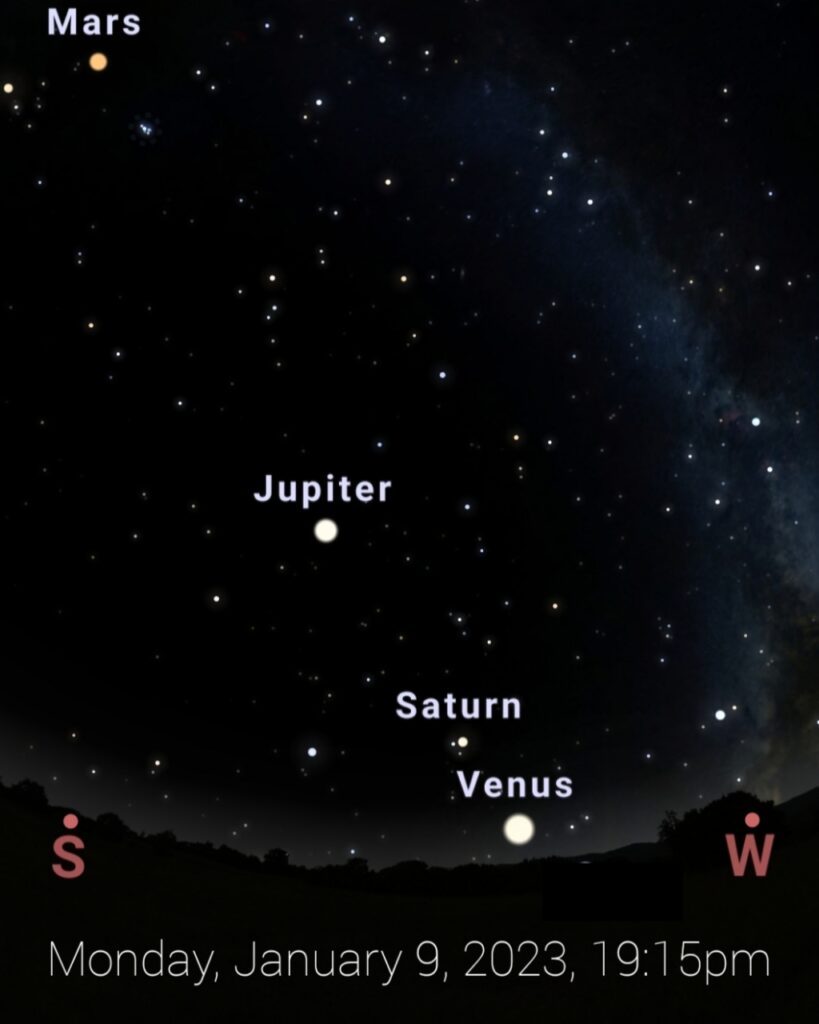Jan 9, 2023 | by Daniel Giamario |
I am not noticing any major highlights this week, except Mars going stationary direct, which my colleague Erik Roth will cover later this week. There are important events later in the month though:
Mercury is going stationary direct on January 18, beginning the new Capricorn synodic overstory.
Uranus is also going stationary direct, on January 22.
Venus and Saturn conjunct on January 22, closely followed by the second chakra evening star Venus portal on January 23.
And another Moon occultation of Mars (with Aldebaran), on January 30, visible in the United States.
In the meantime, let’s look at what’s happening in the sky with the visible planets this week. Take advantage of the evening sky now with the Full Moon just past, rising later and later each day.

MERCURY, 13Capricorn36Retrograde
Not visible all week between the Earth and Sun, Mercury is in the metamorphic shape-shift phase into the archetype of the next synodic overstory of Capricorn, commencing on January 18.
VENUS, 8Aquarius45
Venus is a very bright evening star now at -3.9 magnitude, slowly seen higher in the twilight sky, and rather quickly overtaking a rapidly sinking Saturn. They meet on January 22nd. Venus is currently within the first chakra portal of her evening star Capricorn synodic overstory.
MARS, 8Gemini10Retrograde
Mars is slowly fading in brightness just under -1.0 magnitude. It is still really close to Aldebaran, the eye of the Bull, with another exact conjunction happening on January 30. Mars can be seen after sunset and will be near the zenith facing south around 9:00pm. Mars is currently in Phase One of it’s cycle, termed “Birth and Emergence”, of the Gemini synodic overstory that began December 7, 2022.
JUPITER, 2Aries30
Jupiter also features prominently in the evening sky and can be seen high above at twilight, setting around midnight. It is still unmistakably bright at magnitude -2.4 and is found near the 0Aries Vernal Equinox location below the great square of Pegasus.
SATURN, 23AQuarius21
Saturn is the fourth visible evening star planet. Shining less bright than the other three at magnitude +0.8, Saturn can be seen low in the southwest at nightfall, so shortly after sunset around 7-8pm. Venus soon will have a visible rendezvous with Saturn in the region of the sky where the Goat-Fish and the Water-Bearer share space.
For more on the synodic cycles and their overstories, TOTAMS has an entire course dedicated to this subject which is currently being totally revamped and updated. You can preview it here: https://turningoftheages.com/course5/
Recent useful webinars on Mars:
https://seedpeople.turningoftheages.com/courses/mars-conclusion-webinar
https://seedpeople.turningoftheages.com/bundles/mars-synodic-cycle-series
And Mercury:
https://turningoftheages.com/media/ (scroll down to “2021 All About Mercury)
https://turningoftheages.com/event/december-group-mentoring/ (recording)
